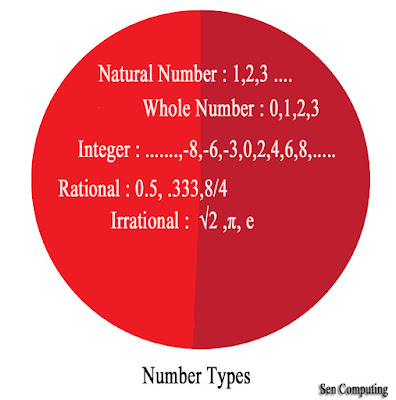There are different types of number in mathematics. Different types of numbers have many different uses. We can also classified them as sets.
Natural Number:
The first type of number is 'natural' numbers. It is also called counting number. These are:
1, 2, 3, 4, 5, 6, ... 40,41 ...100,101 ......
The set of natural numbers, denoted N, can be defined in N ={1,2,3,4}
The set of natural numbers, denoted N, can be defined in N ={1,2,3,4}
Whole Number:
Same as Natural Number. Here it is together with zero:
0, 1, 2, 3, 4, 5, 6, ...
So if we include 0 with natural number then it is whole number.
Integers:
Then come the "integers", which are set of zero, the natural numbers, and the negatives of the naturals. It is written without fractional part. These are:
..., –6, –5, –4, –3, –2, –1, 0, 1, 2, 3, 4, 5, 6, ...
So +8 or -8 both are integer but 8.23 is not integer. 8.23 is a fraction. The set of integers, denoted Z, is formally defined as follows: Z = {..., -3, -2, -1, 0, 1, 2, 3, ...}
Rational numbers:
The rational number is ratio of two integer numbers. So it can be written in the p/q form, where p and q are integers and q is not equal to zero. By dividing one integer by another integer may form a fraction. For example, 5/2=2.5 but 4/2=2 does not make fraction.
So fractions are rational number but remember that fractions should be terminated (ending) or repeating decimals. Such as 1/2=0.5(fraction is terminated), 1.58/2= 0.79(fraction is terminated), or 4/3=1.333333.....(Here fraction is repeating). All these numbers are example of fraction.
Irrational numbers:
Irrational means not Rational. Some numbers cannot be written as a ratio of two integers and they are called irrational number. For example:
√2=1.4142135623730950....... (fraction is non-terminating)
π = 3.1415926535897932384626433832795 (and more...)
Here fraction is endless. The decimal expansion of an irrational number continues without repeating.
Real numbers:
Real number includes all the number: natural,integer,rational and irrational numbers. It is denoted by R.
Real numbers:
Real number includes all the number: natural,integer,rational and irrational numbers. It is denoted by R.





